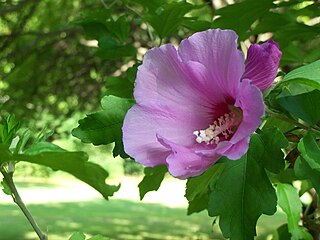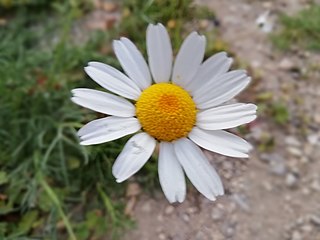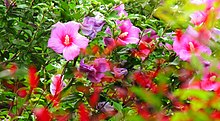
Hydrangea, commonly named the hortensia, is a genus of more than 70 species of flowering plants native to Asia and the Americas. By far the greatest species diversity is in eastern Asia, notably China, Korea, and Japan. Most are shrubs 1–3 m tall, but some are small trees, and others lianas reaching up to 30 m (100 ft) by climbing up trees. They can be either deciduous or evergreen, though the widely cultivated temperate species are all deciduous.

Penstemon, the beardtongues, is a large genus of roughly 280 species of flowering plants native mostly to the Nearctic, but with a few species also found in the North American portion of the Neotropics. It is the largest genus of flowering plants endemic to North America. As well as being the scientific name, penstemon is also widely used as a common name for all Penstemon species alongside beardtongues.

Hibiscus is a genus of flowering plants in the mallow family, Malvaceae. The genus is quite large, comprising several hundred species that are native to warm temperate, subtropical and tropical regions throughout the world. Member species are renowned for their large, showy flowers and those species are commonly known simply as "hibiscus", or less widely known as rose mallow. Other names include hardy hibiscus, rose of sharon, and tropical hibiscus.

Deutzia is a genus of about 60 species of flowering plants in the family Hydrangeaceae, native to eastern and central Asia, and Central America and also Europe. By far the highest species diversity is in China, where 50 species occur.

Rose of Sharon is a biblical expression, though the identity of the plant referred to is unclear and is disputed among biblical scholars. It has become a common name for several different species of flowering plants that are valued in different parts of the world. In neither case does it refer to actual roses. The name's varied colloquial application has been used as an example of the lack of precision of common names, which can potentially cause confusion. "Rose of Sharon" has become a frequently used catch phrase in poetry and lyrics.

Hibiscus rosa-sinensis, known colloquially as Chinese hibiscus, China rose, Hawaiian hibiscus, rose mallow and shoeblack plant, is a species of tropical hibiscus, a flowering plant in the Hibisceae tribe of the family Malvaceae. It is widely cultivated as an ornamental plant in the tropics and subtropics.

Dasiphora fruticosa is a species of hardy deciduous flowering shrub in the family Rosaceae, native to the cool temperate and subarctic regions of the northern hemisphere, often growing at high altitudes in mountains. Dasiphora fruticosa is still widely referenced in the horticultural literature under its synonym Potentilla fruticosa. Common names include shrubby cinquefoil, golden hardhack, bush cinquefoil, shrubby five-finger, widdy, kuril tea and tundra rose.

Hydrangea macrophylla is a species of flowering plant in the family Hydrangeaceae, native to Japan. It is a deciduous shrub growing to 2 m (7 ft) tall by 2.5 m (8 ft) broad with large heads of pink or blue flowers in summer and autumn. Common names include bigleaf hydrangea, French hydrangea, lacecap hydrangea, mophead hydrangea, and hortensia. It is widely cultivated in many parts of the world in many climates. It is not to be confused with H. aspera 'Macrophylla'.

Rosa gallica, the Gallic rose, French rose, or rose of Provins, is a species of flowering plant in the rose family, native to southern and central Europe eastwards to Turkey and the Caucasus. Rosa gallica was one of the first species of rose to be cultivated in central Europe. It is a parent of several important cultivars.

Helianthemum, known as rock rose, sunrose, rushrose, or frostweed, is a genus of about 110 species of flowering plants in the family Cistaceae. They are widely distributed throughout the Northern Hemisphere, especially in the Mediterranean.

Camellia japonica, known as common camellia, or Japanese camellia, is a species of Camellia, a flowering plant genus in the family Theaceae. There are thousands of cultivars of C. japonica in cultivation, with many colors and forms of flowers. Despite its common name, it is native to China, not Japan. The cultivation of Camellia japonica also started in China. Its widespread cultivation can be traced back to the Song Dynasty, when 15 varieties of Camellia japonica were recorded in literature. It was later introduced to Japan. It grows in forests, at altitudes of around 300–1,100 metres (980–3,600 ft).

Weigela is a genus of between six and 38 species of deciduous shrubs in the family Caprifoliaceae, growing to 1–5 m (3–15′) tall. All are natives of eastern Asia. The genus is named after the German scientist Christian Ehrenfried Weigel.

Cornus alba, the red-barked, white or Siberian dogwood, is a species of flowering plant in the family Cornaceae, native to Siberia, northern China and Korea. It is a large deciduous surculose (suckering) shrub that can be grown as a small tree. As a popular ornamental used in landscaping its notable features include the red stems in fall (autumn) through late winter, bright winter bark; and the variegated foliage in some cultivars, such as C. alba 'Elegantissima'. C. alba can grow to 3 m (10 ft) high, but variegated forms are less vigorous. For the brightest winter bark, young shoots are encouraged by cutting to the ground some older stems at the end of the winter, before leaves are open. The oval fruits are white, sometimes tinted blue.

Camellia sasanqua, with common name sasanqua camellia, is a species of Camellia native to southern Japan. It is usually found growing up to an altitude of 900 m (3,000 ft).

Symphyotrichum ericoides, known as white heath aster, frost aster, or heath aster, is a species of flowering plant in the family Asteraceae native to much of central and eastern North America. It has been introduced to parts of Europe and western Asia.

Caryopteris is a genus of flowering plants in the family Lamiaceae. They are native to east Asia.

Spiraea japonica, the Japanese meadowsweet or Japanese spiraea, is a plant in the family Rosaceae.

Argyranthemum frutescens, known as Paris daisy, marguerite or marguerite daisy, is a perennial plant known for its flowers. It is native to the Canary Islands. Hybrids derived from this species are widely cultivated as ornamental plants in private gardens and public parks in many countries, and have naturalized in Italy and southern California. There are many cultivars, but the most common has white petals.

Hydrangea serrata is a species of flowering plant in the family Hydrangeaceae, native to mountainous regions of Korea and Japan. Common names include mountain hydrangea and tea of heaven. Growing to 1.2 m (4 ft) tall and broad, it is a deciduous shrub with oval leaves and panicles of blue and pink flowers in summer and autumn (fall). It is widely cultivated as an attractive ornamental shrub throughout the world in areas with suitable climate and soil.

Acer palmatum, commonly known as Japanese maple, palmate maple, or smooth Japanese maple (Korean: danpungnamu, 단풍나무, Japanese: irohamomiji, イロハモミジ, or momiji,, is a species of woody plant native to Korea, Japan, China, eastern Mongolia, and southeast Russia. Many different cultivars of this maple have been selected and they are grown worldwide for their large variety of attractive forms, leaf shapes, and spectacular colors.


























